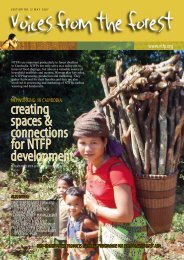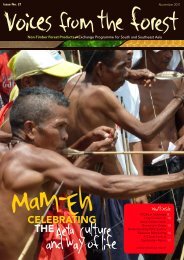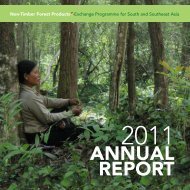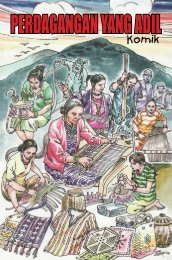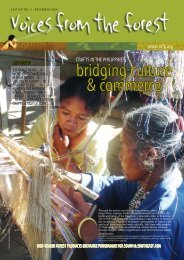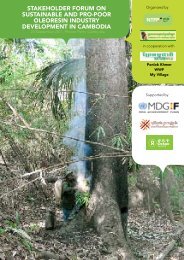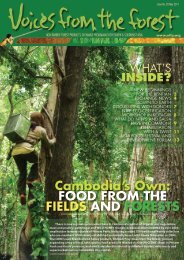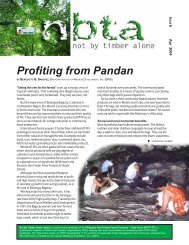annual report - Non-Timber Forest Products Exchange Programme
annual report - Non-Timber Forest Products Exchange Programme
annual report - Non-Timber Forest Products Exchange Programme
Create successful ePaper yourself
Turn your PDF publications into a flip-book with our unique Google optimized e-Paper software.
Preparing the native seedlings for plantingto restore Vietnamese forestsphoto courtesy of Vo Thanh LiemINCOME GENERATIONThere was an exciting market response to new brands andmerchandises introduced by NTFP-EP. These include honeyproducts from NatureWild, fair trade and social marketingarm in Cambodia; various Green shop NTFP medicinalproducts from India; designer bags from Borneo Chic inIndonesia and goods using natural dyes from CustomMadeCrafts Center (CMCC) in the Philippines. Remarkable <strong>annual</strong>sales for Cambodia, India, Indonesia and the Philippines areshown in Table 1. Participatory Guarantee System (PGS) onrattan certification is another marketing tool that is makingheadway in Indonesia with commitments from governmentto support the scheme.Support to various types of community enterprise formationsresulted in increased household incomes of members ofthose groups. The groups include the Bee Conservation andWild Honey Enterprises (CBHE) in Cambodia, the women’sself-help groups (SHGs) and production centers in India,the women’s small enterprise and craft groups in Indonesiaand Malaysia and the community-based NTFP enterprises(CBEs) in the Philippines. The increase in household incomeis documented in the Impact Monitoring Report (IMR)of NTFP-Task Force (TF) from craft products of CBEmembers in the Philippines.The NTFP-EP’s capacity building programmes had integratedresource use management in its community enterprisedevelopment trainings. A specific tool is the “CommunityLivelihood Appraisal and Product/Resource Scanning(CLAPS)” developed by NTFP-TF. It aims to increasethe knowledge of women and men in forest communitiesin managing and developing community enterprises andutilizing NTFP resources sustainably. The NTFP resourceand the existing skills in the community becomes the basisfor the development of potential products for the communityenterprise.The resulting outcome of those initiatives is the increasedconfidence of more women and men in partner communitiesto manage their own enterprises and to lead their respectiveorganizations. Capacity building support included trainingson business planning, natural dye application, communityenterprise development, and fiber processing, among others.It also included technical assistance and market linkaging.Communities were also supported to meet their strategicconcerns including leadership development, particularlyfor the youth, and gender equality. Various enterpriseinterventions contributed to the improvement of theeconomic status of women and men in forest communitiesin the region.Table 1 shows that for 2012, NTFP-EP’s support reacheda total of 545 villages covering 306 enterprise groups thatearned a total gross sale of €376,408.10. At least 6,896 peoplehave directly benefitted from the enterprise developmentcapacity building activities.2012 Annual Report



